Search Result
Results for "
antibiotic peptide
" in MedChemExpress (MCE) Product Catalog:
1
Biochemical Assay Reagents
1
Isotope-Labeled Compounds
| Cat. No. |
Product Name |
Target |
Research Areas |
Chemical Structure |
-
- HY-P5726
-
|
|
Antibiotic
|
Cancer
|
|
Aurein 1.2 is an active amphibian antibiotic peptide with antibiotic and anticancer activities .
|
-

-
- HY-P5728
-
-
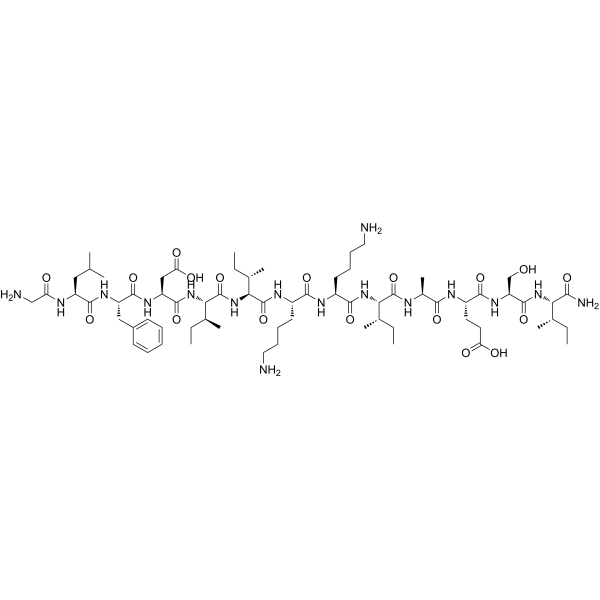
-
- HY-P5725
-
|
|
Bacterial
Antibiotic
|
Infection
|
|
Aurein 2.1 is an antibiotic peptide that can be found in the Australian Bell Frogs Litoria aurea and Litoria raniformis .
|
-
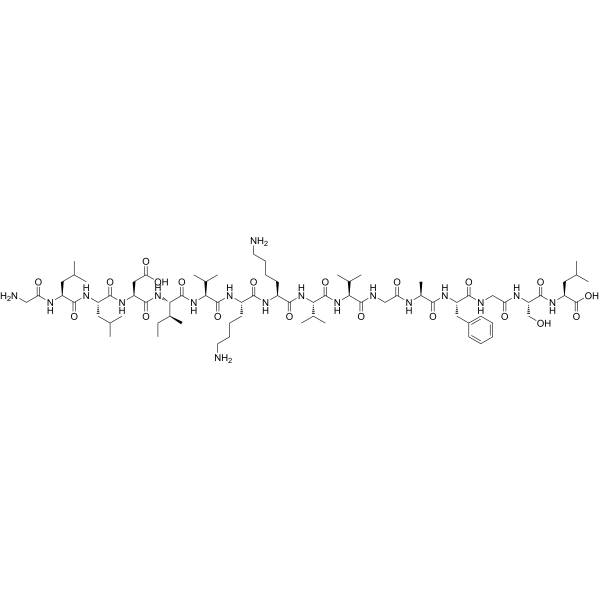
-
- HY-147429A
-
|
Abx MCP TFA; RG6006 TFA
|
Antibiotic
Bacterial
|
Infection
|
|
Zosurabalpin TFA is a tethered macrocyclic peptide antibiotic, acting specifically on A. baumannii. Zosurabalpin TFA inhibits lipopolysaccharide-transport .
|
-

-
- HY-W714002
-
|
|
HIV
Bacterial
|
Infection
|
|
Feglymycin is a HIV replication inhibitor. Feglymycin is also an antibiotic peptide that has antibacterial activity (MIC: 32-64 μg/mL for Staphylococcus aureus) .
|
-
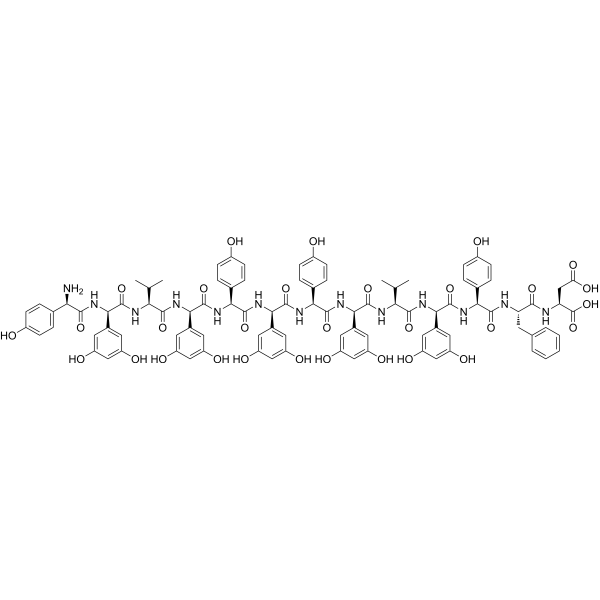
-
- HY-P4848
-
|
|
Antibiotic
|
Infection
|
|
Dermcidin-1L (human) is an antibiotic peptide secreted by sweat glands. Dermcidin-1L (human) has antimicrobial activity. Dermcidin-1L (human) can be used for the research of inflammatory skin disorders .
|
-

-
- HY-P4200
-
|
|
Antibiotic
Bacterial
|
Infection
|
|
Lugdunin is an antibiotic peptide. Lugdunin inhibits bacteria by dissipating their membrane potential. Lugdunin is active against Gram-positive bacteria, such as S. aureus, and reduces S. aureus skin and nasal colonization. Lugdunin induces LL-37 and CXCL8/MIP-2 in human keratinocytes and mouse skin .
|
-
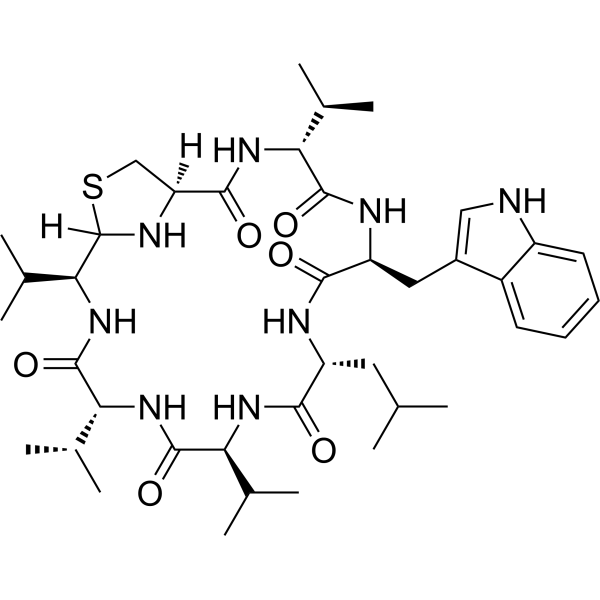
-
- HY-P0311
-
|
|
Bacterial
|
Infection
|
|
LAH4, an alpha-helix of the designed amphipathic peptide antibiotic, exhibits potent antimicrobial, nucleic acid transfection and cell penetration activities. LAH4 possesses high plasmid DNA delivery capacities. LAH4 has a strong affinity for anionic lipids found in the outer membrane of bacterial membranes .
|
-

-
- HY-P0311A
-
|
|
Bacterial
|
Infection
|
|
LAH4 TFA, an alpha-helix of the designed amphipathic peptide antibiotic, exhibits potent antimicrobial, nucleic acid transfection and cell penetration activities. LAH4 TFA possesses high plasmid DNA delivery capacities. LAH4 TFA has a strong affinity for anionic lipids found in the outer membrane of bacterial membranes .
|
-

-
- HY-W142073
-
|
7-Methyltryptophan
|
Amino Acid Derivatives
|
Infection
|
|
7-Methyl-DL-tryptophan (7-Methyltryptophan) is an amino acid derivative, which is a key precursor for biosynthesis of many non-ribosomal peptide antibiotics. 7-Methyl-DL-tryptophan plays an important role in synthesis of high-efficiency antibacterial agents and analogues thereof .
|
-
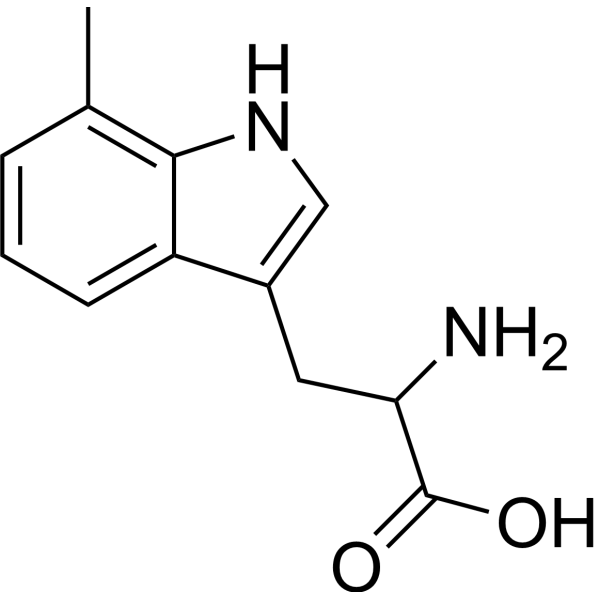
-
- HY-P2302
-
|
|
Antibiotic
Bacterial
Fungal
|
Infection
|
|
Defensin HNP-3 human is a cytotoxic antibiotic peptide known as "defensin". Defensin HNP-3 human has inhibitory activity against Staphylococcus aureus, Pseudomonas aeruginosa and Escherichia coli. Defensin HNP-3 human is initially synthesized as the 94 amino acids preproHNP(1-94), which is hydrolyzed to proHNP(20-94) and converted to mature HNP(65-94) after the removal of anion precursors .
|
-
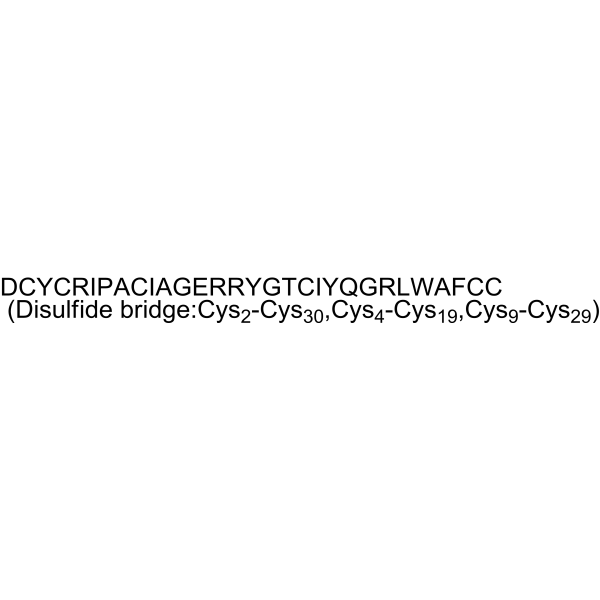
-
- HY-P1674A
-
|
POL7080 TFA
|
Bacterial
Antibiotic
|
Infection
|
|
Murepavadin (POL7080) (TFA), a 14-amino-acid cyclic peptide, is a highly potent, specific antibiotic. Murepavadin exhibits a potent antimicrobial activity for P. aeruginosa with MIC50 and MIC90 values both of 0.12 mg/L. Murepavadin also can target the lipopolysaccharide transport portin D. Murepavadin can be used for the research of bacterial resistance .
|
-

-
- HY-P1674
-
|
POL7080
|
Bacterial
Antibiotic
|
Infection
|
|
Murepavadin (POL7080), a 14-amino-acid cyclic peptide, is a highly potent, specific antibiotic. Murepavadin exhibits a potent antimicrobial activity for P. aeruginosa with both MIC50 and MIC90 values of 0.12 mg/L. Murepavadin also can target the lipopolysaccharide transport portin D. Murepavadin can be used for the research of bacterial resistance .
|
-
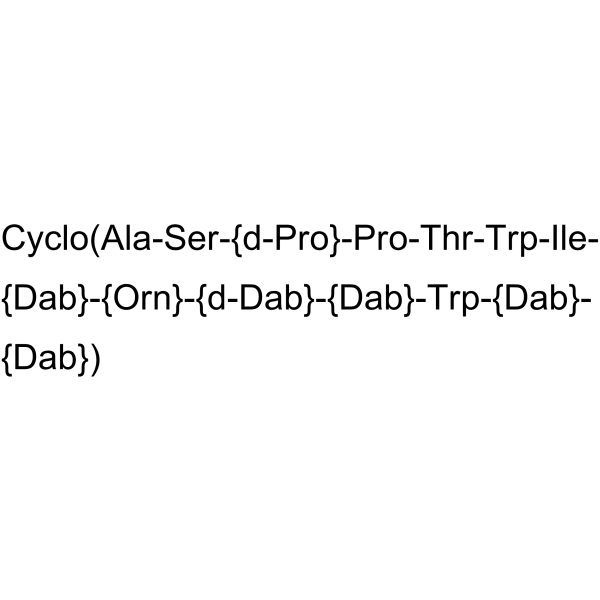
-
- HY-17566
-
-
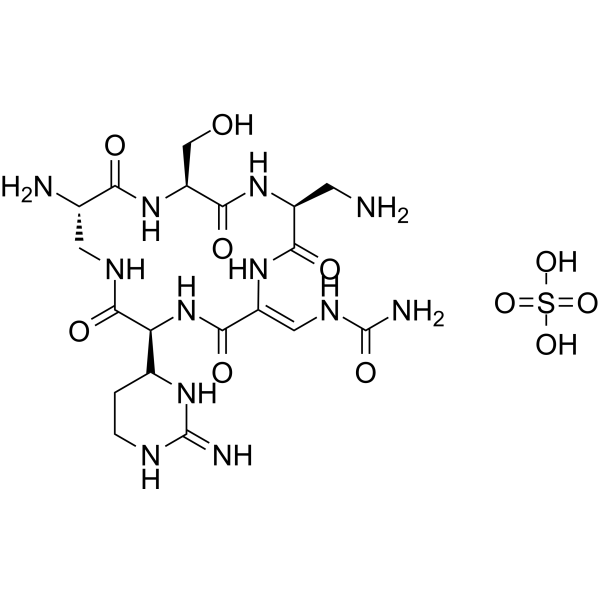
-
- HY-P5707
-
-

-
- HY-P10182
-
-
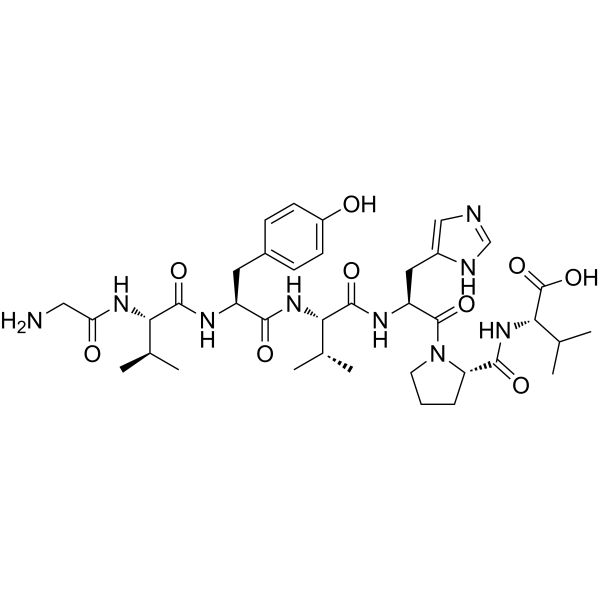
-
- HY-P5577
-
-
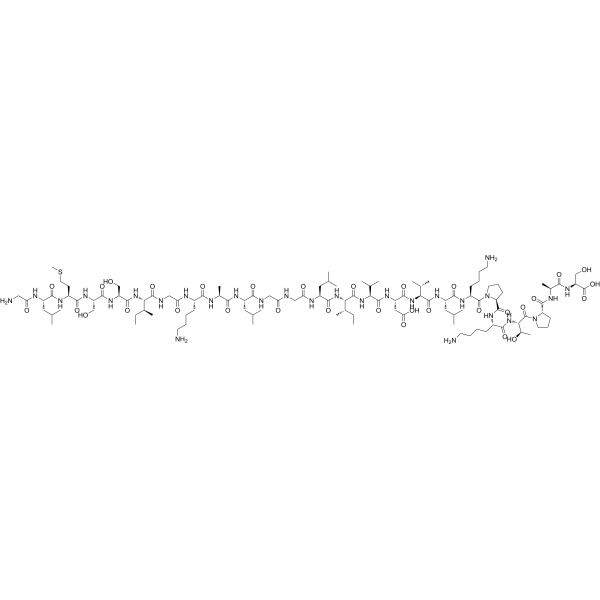
-
- HY-P2311
-
-

-
- HY-P0274
-
|
|
Bacterial
Antibiotic
|
Infection
|
|
PGLa, a 21-residue peptide, is an antimicrobial peptide. PGLa is a member of the magainin family of antibiotic peptides found in frog skin and its secretions .
|
-

-
- HY-P0274A
-
|
|
Bacterial
Antibiotic
|
Infection
|
|
PGLa TFA, a 21-residue peptide, is an antimicrobial peptide. PGLa TFA is a member of the magainin family of antibiotic peptides found in frog skin and its secretions .
|
-

-
- HY-P0092
-
-

-
- HY-P1695
-
|
Ro 09-0198
|
Antibiotic
Bacterial
|
Infection
|
|
Cinnamycin (Ro 09-0198) is a tetracyclic peptide antibiotic that binds specifically to phosphatidylethanolamine (PE) .
|
-

-
- HY-P5575
-
-
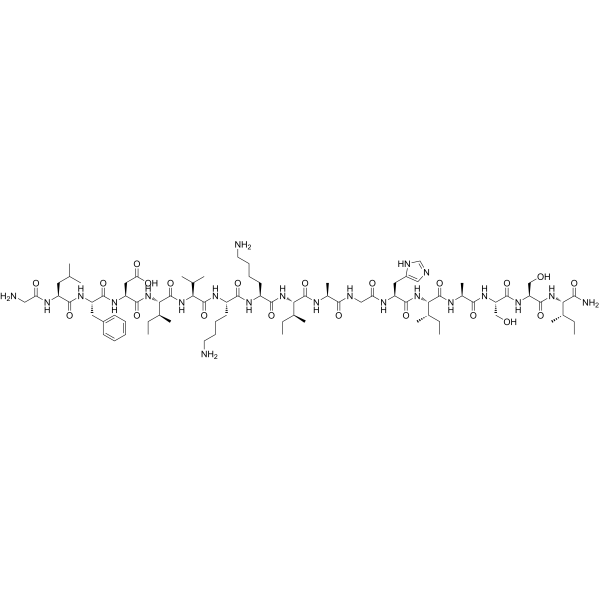
-
- HY-P5576
-
-

-
- HY-E70012
-
|
|
Endogenous Metabolite
|
Infection
Metabolic Disease
|
|
Penicillinase is a beta-lactamase. beta-lactamase enzymes inactivate beta-lactam antibiotics by hydrolyzing the peptide bond of the characteristic four-membered beta-lactam ring rendering the antibiotic ineffective .
|
-

-
- HY-P5572
-
-

-
- HY-P10158
-
|
Porcine cathelicidin PMAP-36
|
Bacterial
|
Infection
|
|
PMAP-36 is an antimicrobial peptide, with sequence of GRFRRLRKKTRKRLKKIGKVLKWIPPIVGSIPLGCG. PMAP-36 with traditional antibiotics can enhance .
|
-

-
- HY-P5571
-
-

-
- HY-N6708
-
|
|
Bacterial
Antibiotic
|
Infection
|
|
Alamethicin, isolated from Trichoderma viride, is a channel-forming peptide antibiotic and induces voltage-gated conductance in model and cell membranes .
|
-

-
- HY-P1872
-
|
|
Bacterial
|
Infection
|
|
OV-1, sheep is an alpha-helical antimicrobial ovispirin peptide derived from SMAP29 peptide (sheep), which inhibits several antibiotic-resistant bacterial strains including mucoid and nonmucoid Pseudomonas aeruginosa .
|
-

-
- HY-P5570
-
|
|
Antibiotic
Bacterial
|
Infection
|
|
Aurein 2.3 is an antibiotic antimicrobial peptide. Aurein 2.3 partially inhibits E.coli ATPase activity and inhibits cell growth .
|
-
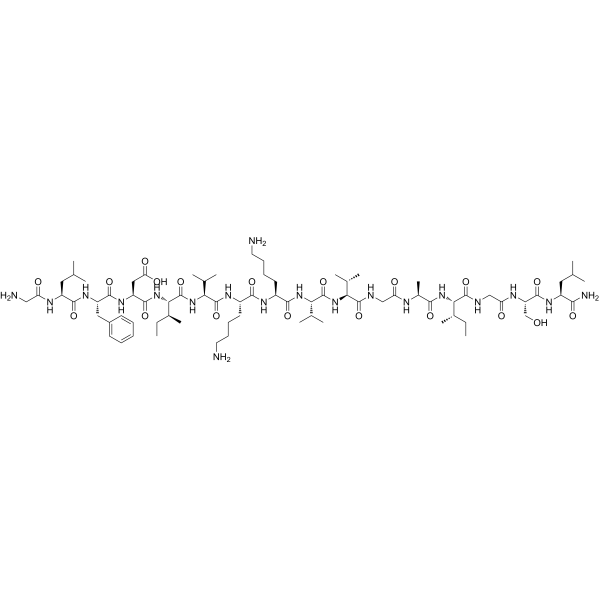
-
- HY-W142064
-
|
|
Antibiotic
|
Others
|
|
Fmoc-L-photo-proline is a photo-crosslinking amino acid which can be incorporated into synthetic peptides using solid-phase Fmoc chemistry. Fmoc-L-photo-proline can synthesis of cyclic peptidomimetic antibiotic and be used for preparation of diverse peptide-based photoaffinity probes research .
|
-
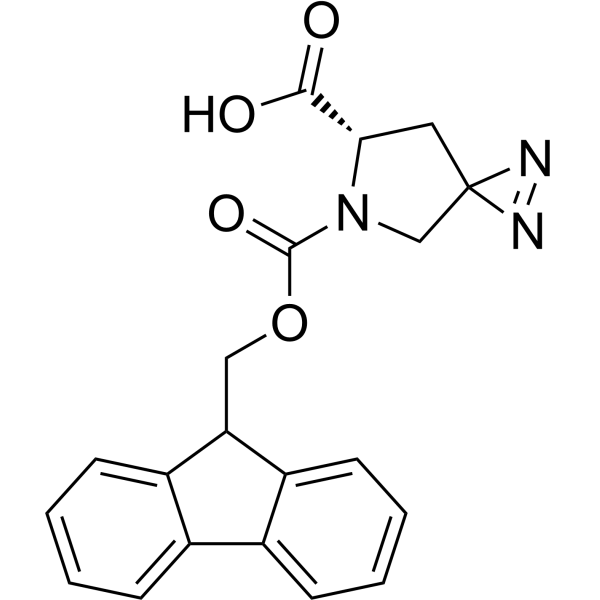
-
- HY-A0162
-
|
|
|
|
|
Quinupristin is a streptogramin antibiotic. Quinupristin blocks peptide bond synthesis to prevent the extension of polypeptide chains and promote the detachment of incomplete protein chains in the bacterial ribosomal subunits .
|
-

-
- HY-A0162A
-
|
|
Bacterial
|
Infection
|
|
Quinupristin mesylate is a streptogramin antibiotic. Quinupristin mesylate blocks peptide bond synthesis to prevent the extension of polypeptide chains and promote the detachment of incomplete protein chains in the bacterial ribosomal subunits .
|
-

-
- HY-P3270
-
|
|
Bacterial
Antibiotic
|
Infection
|
|
Capreomycin is a macrocyclic peptide antibiotic. Capreomycin can be used for anti-multidrug-resistant-tuberculosis research. Capreomycin can inhibit phenylalanine synthesis in in mycobacterial ribosomes translation
|
-

-
- HY-P1975
-
|
Basifungin
|
Fungal
Parasite
|
Infection
Inflammation/Immunology
|
|
Aureobasidin A (Basifungin) is a cyclic peptide antibiotic with oral activity. Aureobasidin A is an inhibitor of inositol phosphorylated ceramide synthetase AUR1. Aureobasidin A has antifungal and antiparasitic activity .
|
-

-
- HY-P5620
-
|
|
Bacterial
|
Infection
|
|
DFTamP1 is an antimicrobial peptide against Staphylococcus aureus USA300 activity (MIC is 3.1 μM) .
|
-
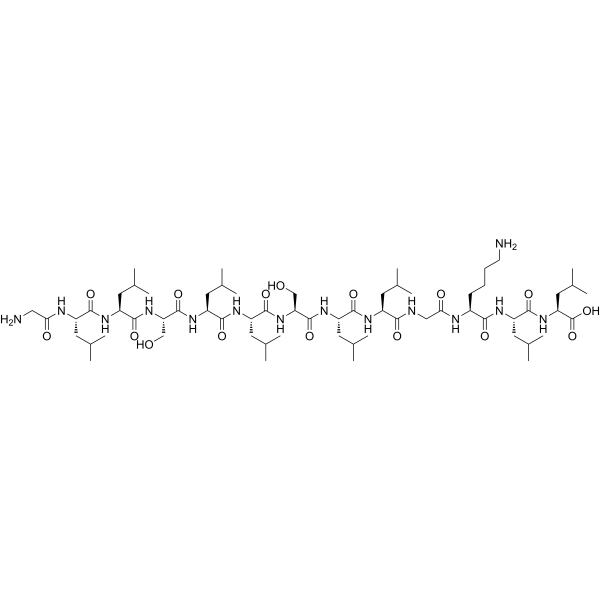
-
- HY-P0269
-
|
Magainin I
|
Bacterial
Fungal
Antibiotic
|
Infection
|
|
Magainin 1 (Magainin I) is an antimicrobial and amphipathic peptide isolated from the skin of Xenopus laevis. Magainin 1 exhibits antibiotic activity against numerous Gram-negative and Gram-positive bacteria .
|
-

-
- HY-118593
-
|
Madumycin II; antibiotic A 2315A
|
Antibiotic
|
Infection
|
|
A2315A (Madumycin II) is an alanine-containing streptogramin A antibiotic. A2315A is a potent peptidyl transferase center (PTC) inhibitor. A2315A inhibits the ribosome prior to the first cycle of peptide bond formation .
|
-
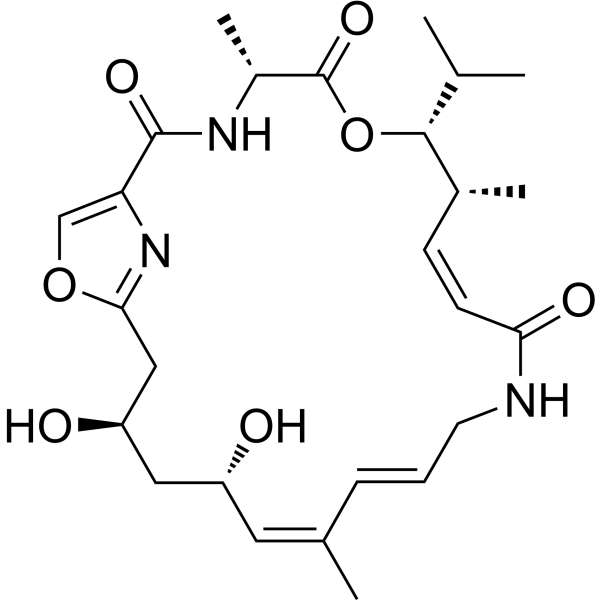
-
- HY-P5708
-
|
Dermaseptin b2
|
Antibiotic
Fungal
Bacterial
|
Infection
|
|
Adenoregulin (Dermaseptin b2) is an antimicrobial peptide antibiotic. Adenoregulin is active against Gram-negative and Gram-positive bacteria, yeast and fungi. Adenoregulin also enhances the binding of agonists to the A1 adenosine receptor .
|
-

-
- HY-P0269A
-
|
Magainin I TFA
|
Bacterial
Fungal
Antibiotic
|
Infection
|
|
Magainin 1 TFA (Magainin I TFA) is an antimicrobial and amphipathic peptide isolated from the skin of Xenopus laevis. Magainin 1 TFA exhibits antibiotic activity against numerous Gram-negative and Gram-positive bacteria .
|
-

-
- HY-P5712
-
|
Gramicidin soviet
|
Antibiotic
Bacterial
|
Infection
|
|
Gramicidin S (Gramicidin soviet) is a cationic cyclic peptide antibiotic. Gramicidin S is active against Gram-negative and Gram-positive bacteria by perturbing integrity of the bacterial membranes. Gramicidin S also inhibits cytochrome bd quinol oxidase .
|
-

-
- HY-P5288
-
|
|
Antibiotic
|
Infection
Cancer
|
|
BMAP-28 is an antibiotic peptide and an inducer of the mitochondrial permeability transition pore. BMAP-28 induces cell death through opening of the mitochondrial permeability transition pore. BMAP-28 can be used in study of microbial infections and cancer .
|
-
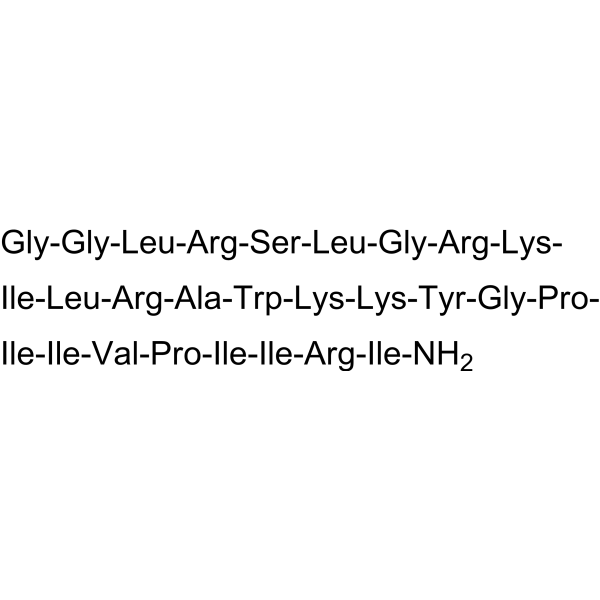
-
- HY-P5573
-
|
|
Antibiotic
Bacterial
|
Infection
|
|
Aurein 2.6 is an antibiotic antimicrobial peptide. Aurein 2.6 is active against Gram-positive bacterial (MIC: 25, 25, 30, 25, 30 μM for M. luteus, S. aureus, S. epidermis, S. mutans, B. subtilis) .
|
-
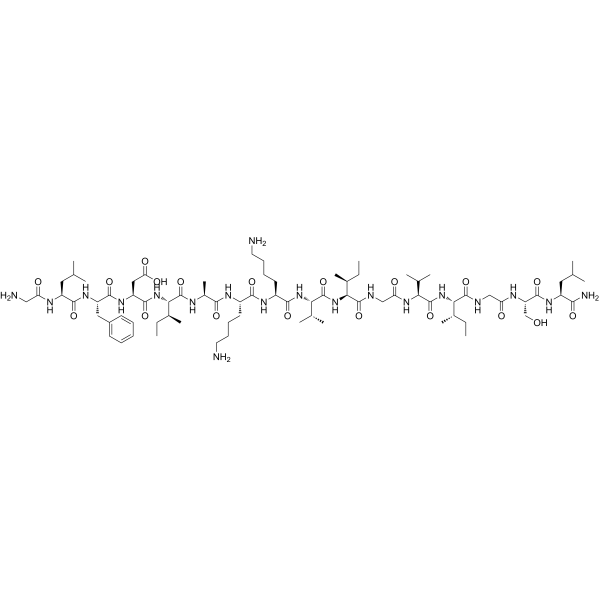
-
- HY-P5574
-
|
|
Antibiotic
Bacterial
|
Infection
|
|
Aurein 3.1 is an antibiotic antimicrobial peptide. Aurein 2.6 is active against Gram-positive bacterial (MIC: 80, 50, 50, 50, 50 μM for M. luteus, S. aureus, S. epidermis, S. mutans, B. subtilis) .
|
-
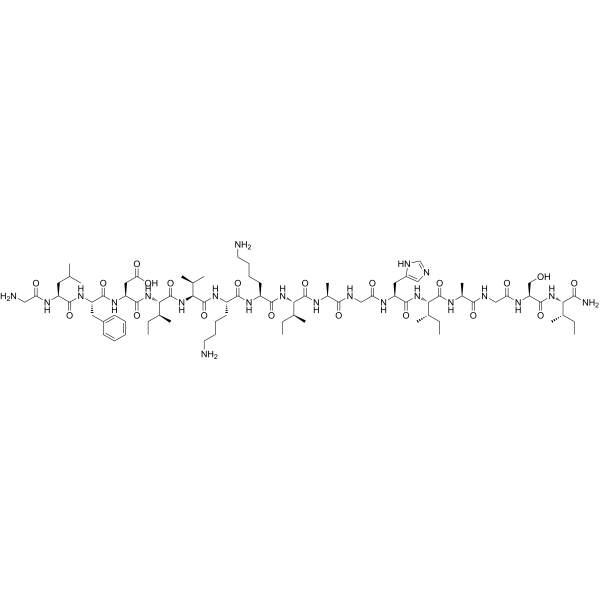
-
- HY-P5016
-
|
|
Antibiotic
Bacterial
Fungal
|
Infection
Cancer
|
|
CRAMP-18 (mouse) is an antibiotic peptide without hemolytic activity. CRAMP-18 (mouse) has good inhibitory activity against Gram-negative bacteria, such as S. typhimurium and P. aeruginosa. CRAMP-18 (mouse) has the potential to study antifungal, antibacterial and antitumor .
|
-
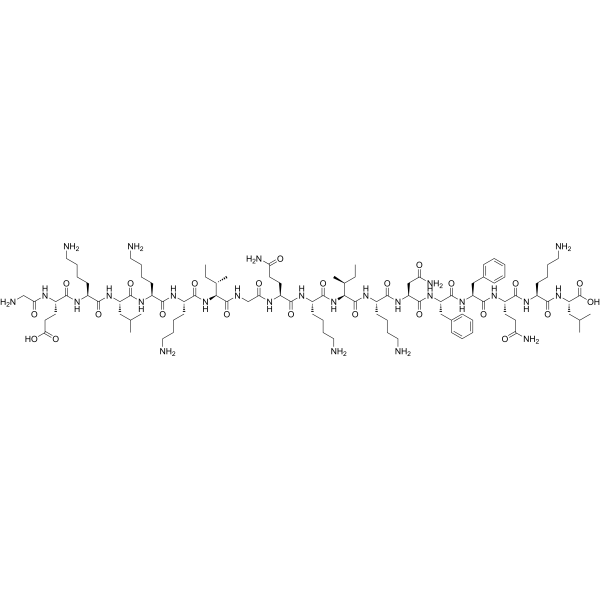
-
- HY-P2324
-
|
|
Bacterial
HIF/HIF Prolyl-Hydroxylase
Antibiotic
|
Infection
Cancer
|
|
Gramicidin A is a peptide component of gramicidin, an antibiotic mixture originally isolated from B. brevis. Gramicidin A is a highly hydrophobic channel-forming ionophore that forms channels in model membranes that are permeable to monovalent cations. Gramicidin A induces degradation of hypoxia inducible factor 1 α (HIF-1α) .
|
-
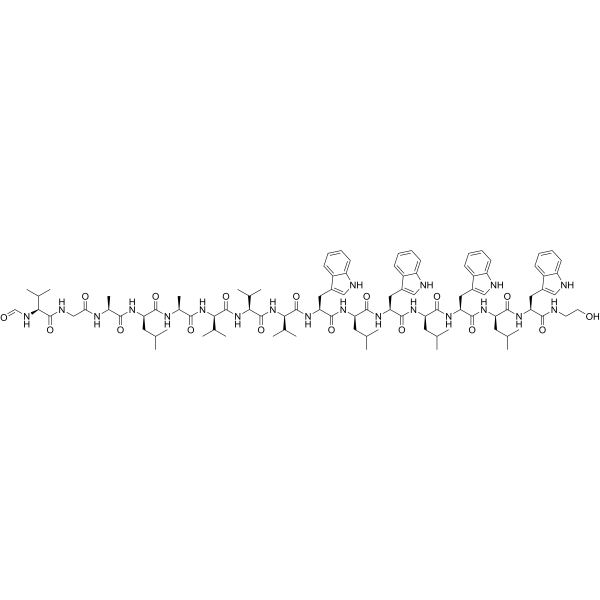
-
- HY-106783
-
|
|
Bacterial
Antibiotic
|
Infection
|
|
Polymyxin B nonapeptide is a cyclic peptide obtained from Polymyxin B by proteolytic removal of its terminal amino acyl residue. Polymyxin B nonapeptide is less toxic, lacks bactericidal activity, and retains its ability to render gram-negative bacteria susceptible to several antibiotics by permeabilizing their outer membranes .
|
-
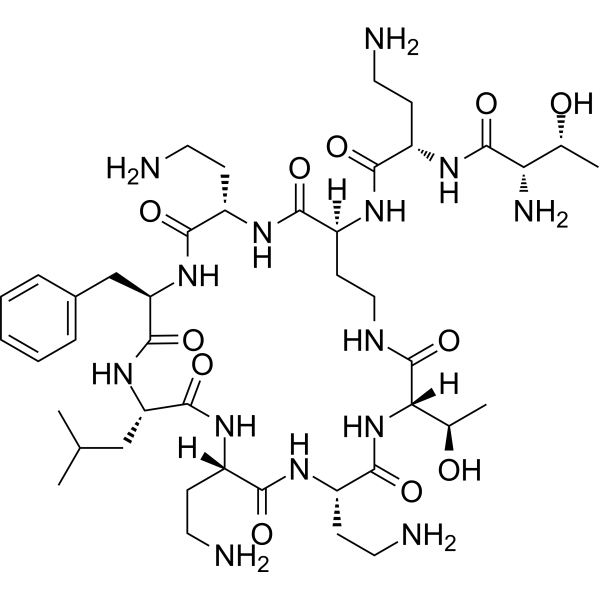
-
- HY-P2312
-
|
HβD-3
|
Antibiotic
Bacterial
|
Infection
|
|
Human β-defensin-3 (HβD-3) is an antibiotic anti-microbial peptide produced by epithelial cells with antimicrobial activities and reduces the effect of inflammatory cytokine responses. Human β-defensin-3 is against different microbes with IC90 values of 6-25 μg/ml .
|
-
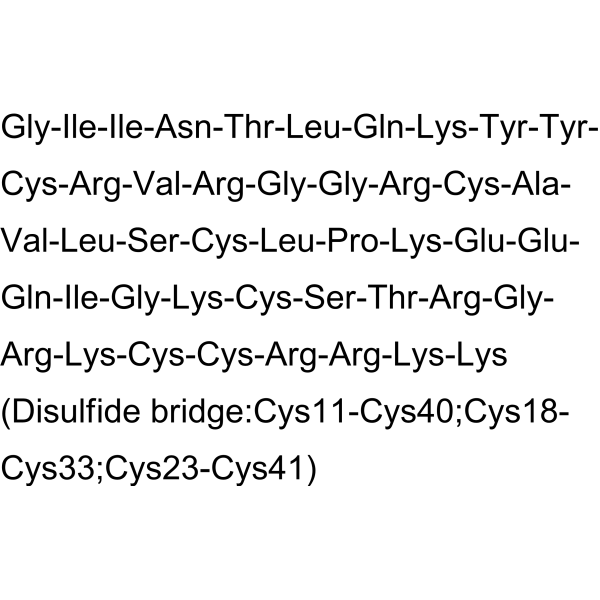
-
- HY-B0239S3
-
|
|
Isotope-Labeled Compounds
Bacterial
Antibiotic
|
Infection
|
|
Chloramphenicol-d4 is deuterium labeled Chloramphenicol. Chloramphenicol, a broad-spectrum antibiotic, acts as a potent inhibitor of bacterial protein biosynthesis[1][2]. Chloramphenicol acts primarily on the 50S subunit of bacterial 70S rihosomes and inhibits peptide bond formation by suppressing peptidyl transferase activity[3].
|
-

- HY-P5680
-
|
|
Bacterial
|
Inflammation/Immunology
|
|
SpHistin is an antimicrobial peptide (AMP). SpHistin can bind to LPS (HY-D1056) and permeabilize the bacterial membrane. SpHistin combined with Rifampicin (HY-B0272) and Azithromycin (HY-17506) promotes the intracellular uptake of the antibiotics and subsequently enhances the bactericidal activity of both agents against P. aeruginosa .
|
-
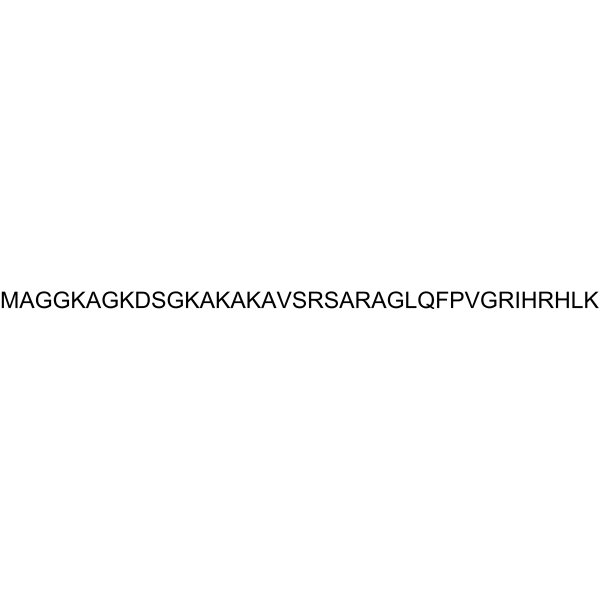
- HY-106783A
-
|
|
Bacterial
Antibiotic
|
Infection
|
|
Polymyxin B nonapeptide TFA is a cyclic peptide obtained from Polymyxin B by proteolytic removal of its terminal amino acyl residue. Polymyxin B nonapeptide TFA is less toxic, lacks bactericidal activity, and retains its ability to render gram-negative bacteria susceptible to several antibiotics by permeabilizing their outer membranes .
|
-
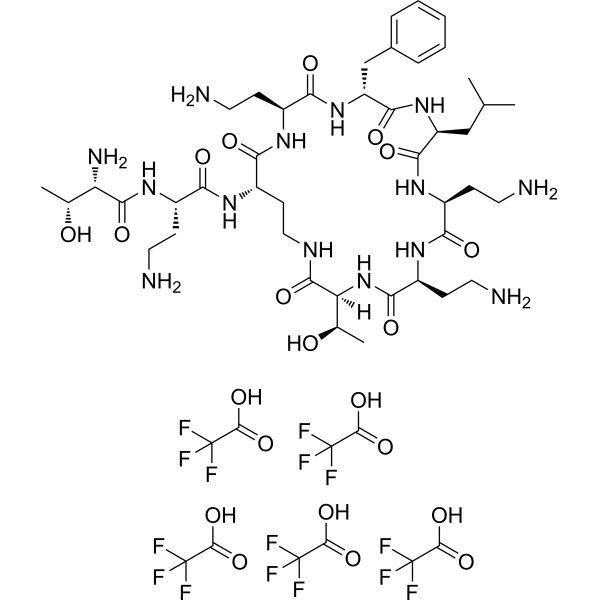
- HY-P2834
-
|
PGA
|
Biochemical Assay Reagents
|
Infection
|
|
Penicillin amidase (EC 3.5.1.11) (Penicillin acylase) is an enzyme that cleaves the acyl side chains of penicillins. Penicillin amidase can be used for the production of 6-aminopenicillanic acid. Penicillin amidase can also be used in the resolution of racemic mixtures, peptide synthesis, and synthesis of semi-synthetic β-lactam antibiotics .
|
-

- HY-P2324A
-
|
|
Antibiotic
Bacterial
|
Infection
|
|
Gramicidin A (TFA) is a peptide component of gramicidin, an antibiotic mixture originally isolated from B. brevis. Gramicidin A (TFA) is a highly hydrophobic channel-forming ionophore that forms channels in model membranes that are permeable to monovalent cations. Gramicidin A (TFA) induces degradation of hypoxia inducible factor 1 α (HIF-1α) .
|
-
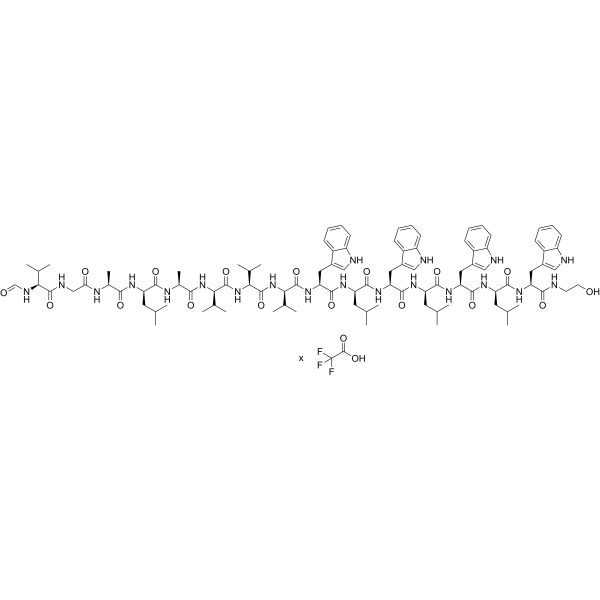
- HY-W012282
-
|
|
Antibiotic
|
Infection
Cancer
|
|
3′-Deoxyuridine is a potential anticancer and antiviral agent. 3'-deoxyuridine inhibits bovine diarrhoea virus (BVDV) production .
|
-
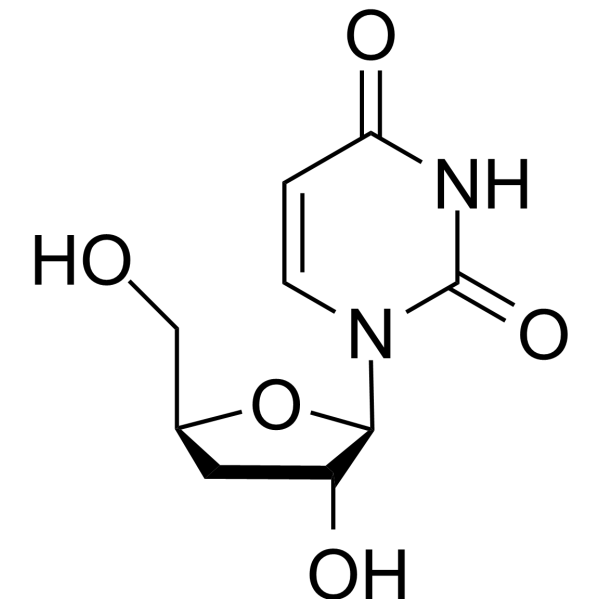
- HY-106882
-
|
MDL 62879
|
Bacterial
Antibiotic
|
Infection
|
|
GE 2270A (MDL 62879) is an antibiotic. GE 2270A inhibits gram-positive bacteria and anaerobes by inhibiting protein synthesis. GE 2270A can be used for the research of infection .
|
-
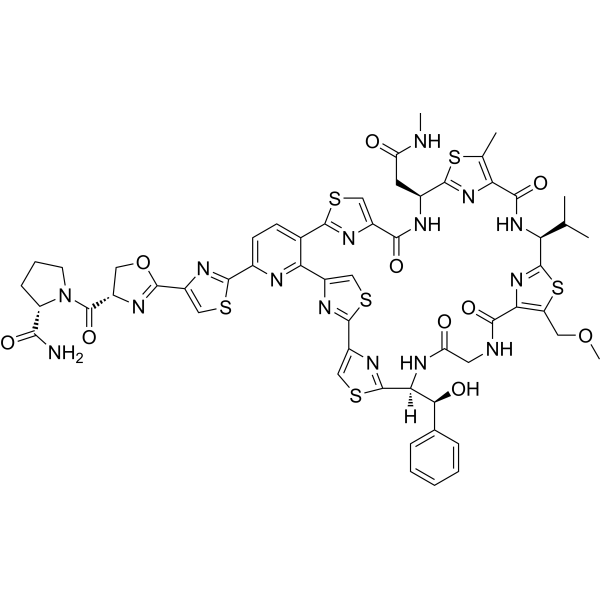
- HY-P0270
-
|
Magainin II
|
Bacterial
Antibiotic
Fungal
|
Infection
|
|
Magainin 2 (Magainin II) is an antimicrobial peptide (AMP) isolated from the skin of the African clawed frog Xenopus laevis. Magainin 2 displays antibiotic activity against numerous gram-negative and gram-positive bacteria. Magainin 2 also is active against protozoa . Magainin 2 exerts its cytotoxicity effects by preferential interactions with anionic phospholipids abundant in bacterial membranes .
|
-

- HY-P1649B
-
|
NAB741 acetate
|
Bacterial
Antibiotic
|
Infection
|
|
SPR741 acetate (NAB741 acetate) is a cationic peptide derived from polymyxin B and is a potentiator molecule. SPR741 acetate increases the permeability of the outer membrane of Gram-negative bacteria and is used to treat severe Gram-negative bacteria infections. SPR741 acetate inhibits multidrug-resistant Gram-negative bacteria. The spectrum of activity of the antibiotic can be widened when used in combination with SPR741 acetate .
|
-
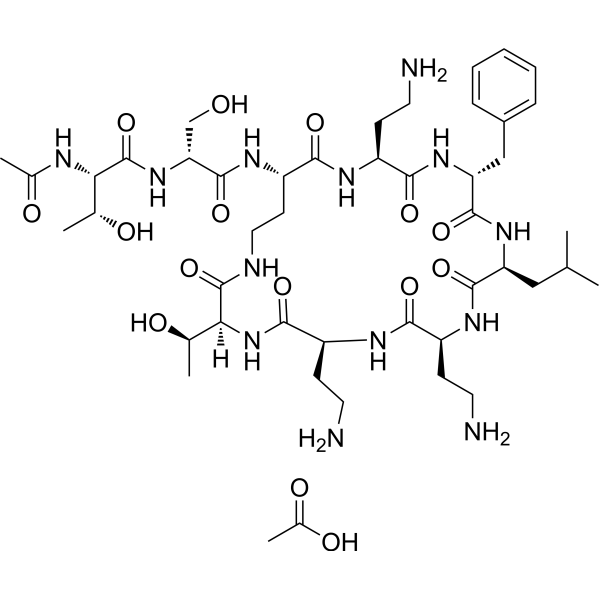
- HY-P1649
-
|
NAB741
|
Bacterial
Antibiotic
|
Infection
|
|
SPR741 (NAB741) is a cationic peptide derived from polymyxin B and is a potentiator molecule. SPR741 increases the permeability of the outer membrane of Gram-negative bacteria and is used to treat severe Gram-negative bacteria infections. SPR741 inhibits multidrug-resistant Gram-negative bacteria. The spectrum of activity of the antibiotic can be widened when used in combination with SPR741 .
|
-
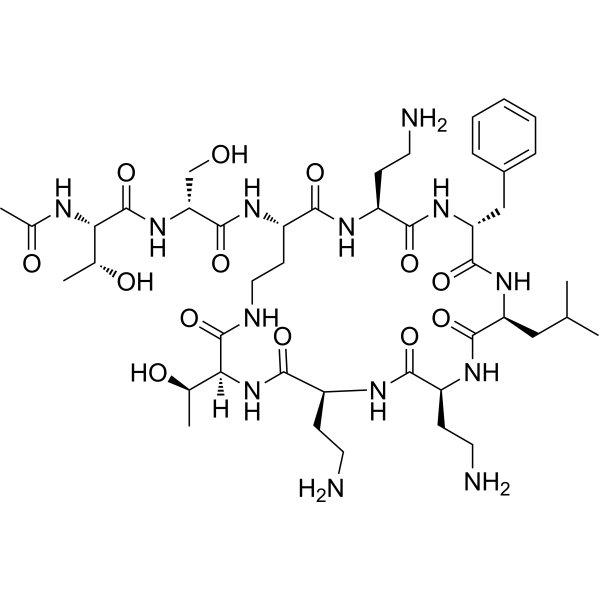
- HY-P1649A
-
|
NAB741 TFA
|
Bacterial
Antibiotic
|
Infection
|
|
SPR741 TFA (NAB741 TFA) is a cationic peptide derived from polymyxin B and is a potentiator molecule. SPR741 TFA increases the permeability of the outer membrane of Gram-negative bacteria and is used to treat severe Gram-negative bacteria infections. SPR741 TFA inhibits multidrug-resistant Gram-negative bacteria. The spectrum of activity of the antibiotic can be widened when used in combination with SPR741 TFA .
|
-

- HY-N6680
-
|
|
Bacterial
Antibiotic
|
Infection
|
|
Virginiamycin S1 is a cyclic hexadepsipeptide antibiotic, inhibits bacterial protein synthesis at the level of aminoacyl-tRNA binding and peptide bond formation. Virginiamycin S1 belongs to the type B compounds in the streptogramin family and is produced by Streptomyces virginiae, shows a strong bactericidal activity against a wide range of Gram-positive bacteria. Virginiamycin S1 together with virginiamycin M1 is more effective in treat multidrug-resistant bacterial infections [1][2].
|
-
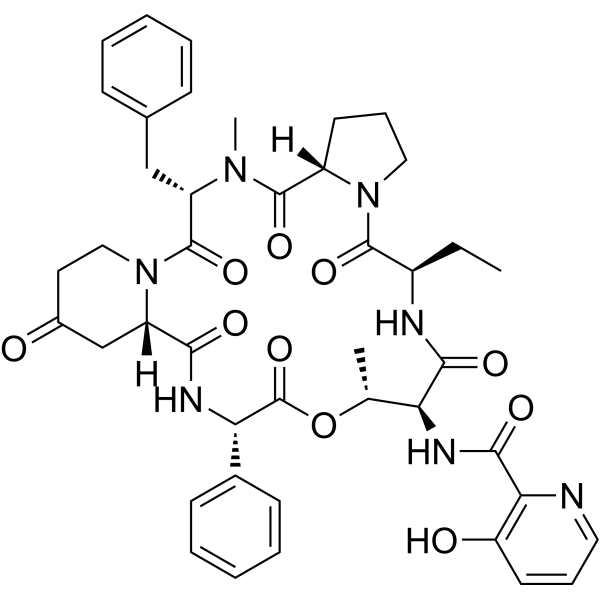
- HY-P5704
-
|
|
Bacterial
|
Infection
|
|
K11 is an antimicrobial peptide. K11 is active against MDR/XDR K. pneumoniae isolates (MIC: 8-512 μg/mL), and inhibits bacterial biofilm formation. K11 can act synergistically with antibiotics (Chloramphenicol (HY-B0239), Meropenem (HY-13678), Rifampicin (HY-B0272), etc.) against drug-resistant K. pneumoniae. K11 has high thermal and wide pH stability .
|
-
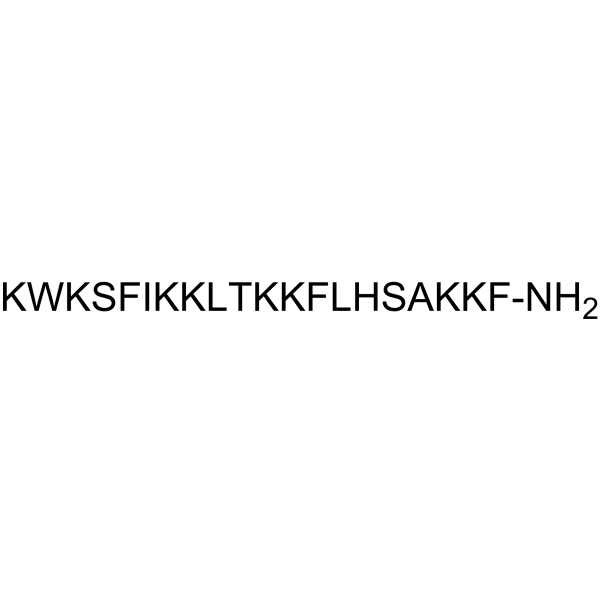
- HY-400684
-
|
|
Others
|
Cancer
|
|
Tubulysin A intermediate-1 is an intermediate in the synthesis of the cytotoxic peptide Tubulysin A (HY-15995). Tubulysin A (TubA) is an antibiotic, anti-microtubule toxins, and apoptosis inducer isolated from myxobacteria. Tubulysin A has anti-angiogenic, anti-microtubule, anti-mitotic, and anti-proliferative activities. Tubulysin A arrests cells in the G2/M phase, effectively inhibits tubulin polymerization, and induces depolymerization of detached microtubules. Tubulysin A acts as an ADC cytotoxin (ADC Cytotoxin) to synthesize ADC .
|
-
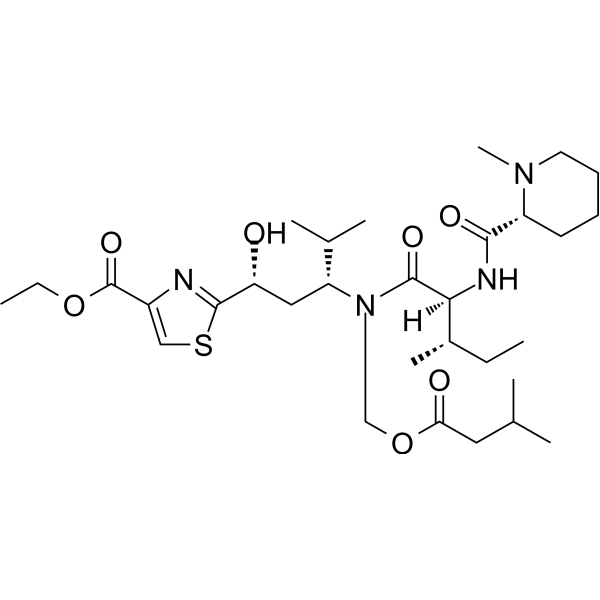
- HY-P2200
-
|
BMY-29304
|
HIV
Antibiotic
|
Infection
Inflammation/Immunology
|
|
Siamycin I (BMY-29304), a 21-residue tricyclic peptide, is a secondary metabolite in actinomycetes. Siamycin I is a HIV fusion inhibitor with ED50s of 0.05 to 5.7 μM for acute HIV type 1 (HIV-1) and HIV-2 infections. Siamycin I inhibits the gelatinase and gelatinase biosynthesis-activating pheromone (GBAP) signaling via the FsrC-FsrA two-component regulatory system in a noncompetitive manner. Siamycin I suppresses the expression of both fsrBDC and gelE-sprE transcripts. Siamycin I, a lasso peptide, interacts with lipid II and inhibits cell wall biosynthesis. Siamycin I, an antibiotic, has the potential for enterococcal infections research .
|
-
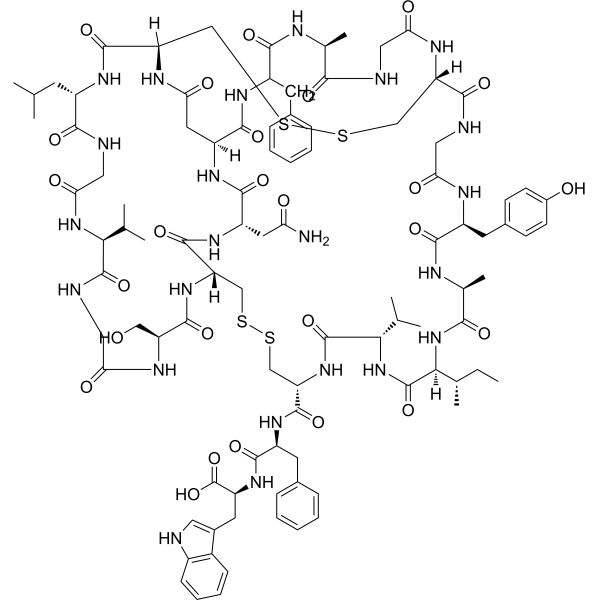
- HY-113952
-
|
(-)-Actinonin
|
Aminopeptidase
Bacterial
MMP
Apoptosis
Antibiotic
|
Infection
Cancer
|
|
Actinonin ((-)-Actinonin) is a naturally occurring antibacterial agent produced by Actinomyces. Actinonin inhibits aminopeptidase M, aminopeptidase N and leucine aminopeptidase. Actinonin is a potent reversible peptide deformylase (PDF) inhibitor with a Ki of 0.28 nM. Actinonin also inhibits MMP-1, MMP-3, MMP-8, MMP-9, and hmeprin α with Ki values of 300 nM, 1,700 nM, 190 nM, 330 nM, and 20 nM, respectively. Actinonin is an apoptosis inducer. Actinonin has antiproliferative and antitumor activities .
|
-
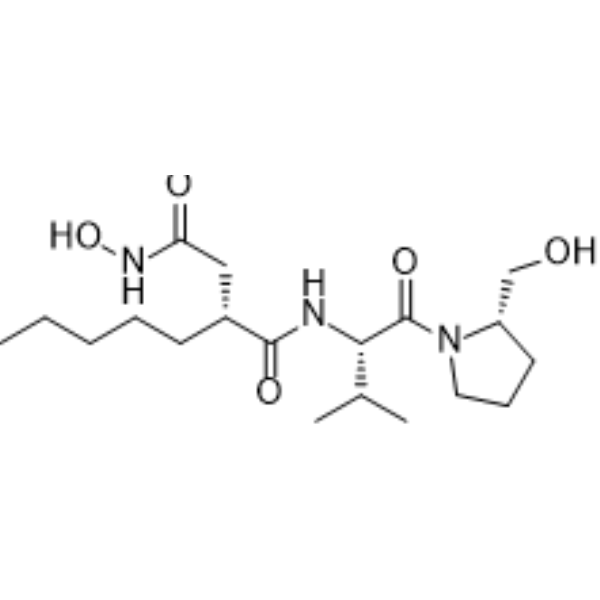
- HY-125728
-
|
|
Bacterial
Parasite
HCV
|
Infection
|
|
Micrococcin P1 is a macrocyclic peptide antibiotic and is a potent hepatitis C virus (HCV) inhibitor with an EC50 range of 0.1-0.5 μM . Micrococcin P1 has in vitro antibacterial activity against Gram-positive bacterial strains. The MIC values of Micrococcin P1 against S. aureus 1974149, E. faecalis 1674621 and S. pyogenes 1744264 are 2 μg/mL, 1 μg/mL and 1 μg/mL, respectively . Micrococcin P1 is also a potent inhibitor of the malaria parasite Plasmodium falciparum .
|
-

| Cat. No. |
Product Name |
Type |
-
- HY-E70012
-
|
|
Biochemical Assay Reagents
|
|
Penicillinase is a beta-lactamase. beta-lactamase enzymes inactivate beta-lactam antibiotics by hydrolyzing the peptide bond of the characteristic four-membered beta-lactam ring rendering the antibiotic ineffective .
|
| Cat. No. |
Product Name |
Target |
Research Area |
-
- HY-P5726
-
|
|
Antibiotic
|
Cancer
|
|
Aurein 1.2 is an active amphibian antibiotic peptide with antibiotic and anticancer activities .
|
-
- HY-P5728
-
-
- HY-P5725
-
|
|
Bacterial
Antibiotic
|
Infection
|
|
Aurein 2.1 is an antibiotic peptide that can be found in the Australian Bell Frogs Litoria aurea and Litoria raniformis .
|
-
- HY-W714002
-
|
|
HIV
Bacterial
|
Infection
|
|
Feglymycin is a HIV replication inhibitor. Feglymycin is also an antibiotic peptide that has antibacterial activity (MIC: 32-64 μg/mL for Staphylococcus aureus) .
|
-
- HY-P4848
-
|
|
Antibiotic
|
Infection
|
|
Dermcidin-1L (human) is an antibiotic peptide secreted by sweat glands. Dermcidin-1L (human) has antimicrobial activity. Dermcidin-1L (human) can be used for the research of inflammatory skin disorders .
|
-
- HY-P4200
-
|
|
Antibiotic
Bacterial
|
Infection
|
|
Lugdunin is an antibiotic peptide. Lugdunin inhibits bacteria by dissipating their membrane potential. Lugdunin is active against Gram-positive bacteria, such as S. aureus, and reduces S. aureus skin and nasal colonization. Lugdunin induces LL-37 and CXCL8/MIP-2 in human keratinocytes and mouse skin .
|
-
- HY-P0311
-
|
|
Bacterial
|
Infection
|
|
LAH4, an alpha-helix of the designed amphipathic peptide antibiotic, exhibits potent antimicrobial, nucleic acid transfection and cell penetration activities. LAH4 possesses high plasmid DNA delivery capacities. LAH4 has a strong affinity for anionic lipids found in the outer membrane of bacterial membranes .
|
-
- HY-P0311A
-
|
|
Bacterial
|
Infection
|
|
LAH4 TFA, an alpha-helix of the designed amphipathic peptide antibiotic, exhibits potent antimicrobial, nucleic acid transfection and cell penetration activities. LAH4 TFA possesses high plasmid DNA delivery capacities. LAH4 TFA has a strong affinity for anionic lipids found in the outer membrane of bacterial membranes .
|
-
- HY-W142073
-
|
7-Methyltryptophan
|
Amino Acid Derivatives
|
Infection
|
|
7-Methyl-DL-tryptophan (7-Methyltryptophan) is an amino acid derivative, which is a key precursor for biosynthesis of many non-ribosomal peptide antibiotics. 7-Methyl-DL-tryptophan plays an important role in synthesis of high-efficiency antibacterial agents and analogues thereof .
|
-
- HY-P2302
-
|
|
Antibiotic
Bacterial
Fungal
|
Infection
|
|
Defensin HNP-3 human is a cytotoxic antibiotic peptide known as "defensin". Defensin HNP-3 human has inhibitory activity against Staphylococcus aureus, Pseudomonas aeruginosa and Escherichia coli. Defensin HNP-3 human is initially synthesized as the 94 amino acids preproHNP(1-94), which is hydrolyzed to proHNP(20-94) and converted to mature HNP(65-94) after the removal of anion precursors .
|
-
- HY-P1674A
-
|
POL7080 TFA
|
Bacterial
Antibiotic
|
Infection
|
|
Murepavadin (POL7080) (TFA), a 14-amino-acid cyclic peptide, is a highly potent, specific antibiotic. Murepavadin exhibits a potent antimicrobial activity for P. aeruginosa with MIC50 and MIC90 values both of 0.12 mg/L. Murepavadin also can target the lipopolysaccharide transport portin D. Murepavadin can be used for the research of bacterial resistance .
|
-
- HY-P1674
-
|
POL7080
|
Bacterial
Antibiotic
|
Infection
|
|
Murepavadin (POL7080), a 14-amino-acid cyclic peptide, is a highly potent, specific antibiotic. Murepavadin exhibits a potent antimicrobial activity for P. aeruginosa with both MIC50 and MIC90 values of 0.12 mg/L. Murepavadin also can target the lipopolysaccharide transport portin D. Murepavadin can be used for the research of bacterial resistance .
|
-
- HY-P5707
-
-
- HY-P10182
-
-
- HY-P5577
-
-
- HY-P2311
-
-
- HY-P0274
-
|
|
Bacterial
Antibiotic
|
Infection
|
|
PGLa, a 21-residue peptide, is an antimicrobial peptide. PGLa is a member of the magainin family of antibiotic peptides found in frog skin and its secretions .
|
-
- HY-P0274A
-
|
|
Bacterial
Antibiotic
|
Infection
|
|
PGLa TFA, a 21-residue peptide, is an antimicrobial peptide. PGLa TFA is a member of the magainin family of antibiotic peptides found in frog skin and its secretions .
|
-
- HY-P0092
-
-
- HY-P5575
-
-
- HY-P5576
-
-
- HY-P5572
-
-
- HY-P10158
-
|
Porcine cathelicidin PMAP-36
|
Bacterial
|
Infection
|
|
PMAP-36 is an antimicrobial peptide, with sequence of GRFRRLRKKTRKRLKKIGKVLKWIPPIVGSIPLGCG. PMAP-36 with traditional antibiotics can enhance .
|
-
- HY-P5571
-
-
- HY-N6708
-
|
|
Bacterial
Antibiotic
|
Infection
|
|
Alamethicin, isolated from Trichoderma viride, is a channel-forming peptide antibiotic and induces voltage-gated conductance in model and cell membranes .
|
-
- HY-P1872
-
|
|
Bacterial
|
Infection
|
|
OV-1, sheep is an alpha-helical antimicrobial ovispirin peptide derived from SMAP29 peptide (sheep), which inhibits several antibiotic-resistant bacterial strains including mucoid and nonmucoid Pseudomonas aeruginosa .
|
-
- HY-P5570
-
|
|
Antibiotic
Bacterial
|
Infection
|
|
Aurein 2.3 is an antibiotic antimicrobial peptide. Aurein 2.3 partially inhibits E.coli ATPase activity and inhibits cell growth .
|
-
- HY-A0162A
-
|
|
Bacterial
|
Infection
|
|
Quinupristin mesylate is a streptogramin antibiotic. Quinupristin mesylate blocks peptide bond synthesis to prevent the extension of polypeptide chains and promote the detachment of incomplete protein chains in the bacterial ribosomal subunits .
|
-
- HY-P3270
-
|
|
Bacterial
Antibiotic
|
Infection
|
|
Capreomycin is a macrocyclic peptide antibiotic. Capreomycin can be used for anti-multidrug-resistant-tuberculosis research. Capreomycin can inhibit phenylalanine synthesis in in mycobacterial ribosomes translation
|
-
- HY-P1975
-
|
Basifungin
|
Fungal
Parasite
|
Infection
Inflammation/Immunology
|
|
Aureobasidin A (Basifungin) is a cyclic peptide antibiotic with oral activity. Aureobasidin A is an inhibitor of inositol phosphorylated ceramide synthetase AUR1. Aureobasidin A has antifungal and antiparasitic activity .
|
-
- HY-P5620
-
|
|
Bacterial
|
Infection
|
|
DFTamP1 is an antimicrobial peptide against Staphylococcus aureus USA300 activity (MIC is 3.1 μM) .
|
-
- HY-P0269
-
|
Magainin I
|
Bacterial
Fungal
Antibiotic
|
Infection
|
|
Magainin 1 (Magainin I) is an antimicrobial and amphipathic peptide isolated from the skin of Xenopus laevis. Magainin 1 exhibits antibiotic activity against numerous Gram-negative and Gram-positive bacteria .
|
-
- HY-P5708
-
|
Dermaseptin b2
|
Antibiotic
Fungal
Bacterial
|
Infection
|
|
Adenoregulin (Dermaseptin b2) is an antimicrobial peptide antibiotic. Adenoregulin is active against Gram-negative and Gram-positive bacteria, yeast and fungi. Adenoregulin also enhances the binding of agonists to the A1 adenosine receptor .
|
-
- HY-P0269A
-
|
Magainin I TFA
|
Bacterial
Fungal
Antibiotic
|
Infection
|
|
Magainin 1 TFA (Magainin I TFA) is an antimicrobial and amphipathic peptide isolated from the skin of Xenopus laevis. Magainin 1 TFA exhibits antibiotic activity against numerous Gram-negative and Gram-positive bacteria .
|
-
- HY-P5712
-
|
Gramicidin soviet
|
Antibiotic
Bacterial
|
Infection
|
|
Gramicidin S (Gramicidin soviet) is a cationic cyclic peptide antibiotic. Gramicidin S is active against Gram-negative and Gram-positive bacteria by perturbing integrity of the bacterial membranes. Gramicidin S also inhibits cytochrome bd quinol oxidase .
|
-
- HY-P5288
-
|
|
Antibiotic
|
Infection
Cancer
|
|
BMAP-28 is an antibiotic peptide and an inducer of the mitochondrial permeability transition pore. BMAP-28 induces cell death through opening of the mitochondrial permeability transition pore. BMAP-28 can be used in study of microbial infections and cancer .
|
-
- HY-P5573
-
|
|
Antibiotic
Bacterial
|
Infection
|
|
Aurein 2.6 is an antibiotic antimicrobial peptide. Aurein 2.6 is active against Gram-positive bacterial (MIC: 25, 25, 30, 25, 30 μM for M. luteus, S. aureus, S. epidermis, S. mutans, B. subtilis) .
|
-
- HY-P5574
-
|
|
Antibiotic
Bacterial
|
Infection
|
|
Aurein 3.1 is an antibiotic antimicrobial peptide. Aurein 2.6 is active against Gram-positive bacterial (MIC: 80, 50, 50, 50, 50 μM for M. luteus, S. aureus, S. epidermis, S. mutans, B. subtilis) .
|
-
- HY-P5016
-
|
|
Antibiotic
Bacterial
Fungal
|
Infection
Cancer
|
|
CRAMP-18 (mouse) is an antibiotic peptide without hemolytic activity. CRAMP-18 (mouse) has good inhibitory activity against Gram-negative bacteria, such as S. typhimurium and P. aeruginosa. CRAMP-18 (mouse) has the potential to study antifungal, antibacterial and antitumor .
|
-
- HY-P2324
-
|
|
Bacterial
HIF/HIF Prolyl-Hydroxylase
Antibiotic
|
Infection
Cancer
|
|
Gramicidin A is a peptide component of gramicidin, an antibiotic mixture originally isolated from B. brevis. Gramicidin A is a highly hydrophobic channel-forming ionophore that forms channels in model membranes that are permeable to monovalent cations. Gramicidin A induces degradation of hypoxia inducible factor 1 α (HIF-1α) .
|
-
- HY-106783
-
|
|
Bacterial
Antibiotic
|
Infection
|
|
Polymyxin B nonapeptide is a cyclic peptide obtained from Polymyxin B by proteolytic removal of its terminal amino acyl residue. Polymyxin B nonapeptide is less toxic, lacks bactericidal activity, and retains its ability to render gram-negative bacteria susceptible to several antibiotics by permeabilizing their outer membranes .
|
-
- HY-P2312
-
|
HβD-3
|
Antibiotic
Bacterial
|
Infection
|
|
Human β-defensin-3 (HβD-3) is an antibiotic anti-microbial peptide produced by epithelial cells with antimicrobial activities and reduces the effect of inflammatory cytokine responses. Human β-defensin-3 is against different microbes with IC90 values of 6-25 μg/ml .
|
-
- HY-P5680
-
|
|
Bacterial
|
Inflammation/Immunology
|
|
SpHistin is an antimicrobial peptide (AMP). SpHistin can bind to LPS (HY-D1056) and permeabilize the bacterial membrane. SpHistin combined with Rifampicin (HY-B0272) and Azithromycin (HY-17506) promotes the intracellular uptake of the antibiotics and subsequently enhances the bactericidal activity of both agents against P. aeruginosa .
|
-
- HY-106783A
-
|
|
Bacterial
Antibiotic
|
Infection
|
|
Polymyxin B nonapeptide TFA is a cyclic peptide obtained from Polymyxin B by proteolytic removal of its terminal amino acyl residue. Polymyxin B nonapeptide TFA is less toxic, lacks bactericidal activity, and retains its ability to render gram-negative bacteria susceptible to several antibiotics by permeabilizing their outer membranes .
|
-
- HY-P2324A
-
|
|
Antibiotic
Bacterial
|
Infection
|
|
Gramicidin A (TFA) is a peptide component of gramicidin, an antibiotic mixture originally isolated from B. brevis. Gramicidin A (TFA) is a highly hydrophobic channel-forming ionophore that forms channels in model membranes that are permeable to monovalent cations. Gramicidin A (TFA) induces degradation of hypoxia inducible factor 1 α (HIF-1α) .
|
-
- HY-106882
-
|
MDL 62879
|
Bacterial
Antibiotic
|
Infection
|
|
GE 2270A (MDL 62879) is an antibiotic. GE 2270A inhibits gram-positive bacteria and anaerobes by inhibiting protein synthesis. GE 2270A can be used for the research of infection .
|
-
- HY-P0270
-
|
Magainin II
|
Bacterial
Antibiotic
Fungal
|
Infection
|
|
Magainin 2 (Magainin II) is an antimicrobial peptide (AMP) isolated from the skin of the African clawed frog Xenopus laevis. Magainin 2 displays antibiotic activity against numerous gram-negative and gram-positive bacteria. Magainin 2 also is active against protozoa . Magainin 2 exerts its cytotoxicity effects by preferential interactions with anionic phospholipids abundant in bacterial membranes .
|
-
- HY-P1649B
-
|
NAB741 acetate
|
Bacterial
Antibiotic
|
Infection
|
|
SPR741 acetate (NAB741 acetate) is a cationic peptide derived from polymyxin B and is a potentiator molecule. SPR741 acetate increases the permeability of the outer membrane of Gram-negative bacteria and is used to treat severe Gram-negative bacteria infections. SPR741 acetate inhibits multidrug-resistant Gram-negative bacteria. The spectrum of activity of the antibiotic can be widened when used in combination with SPR741 acetate .
|
-
- HY-P1649
-
|
NAB741
|
Bacterial
Antibiotic
|
Infection
|
|
SPR741 (NAB741) is a cationic peptide derived from polymyxin B and is a potentiator molecule. SPR741 increases the permeability of the outer membrane of Gram-negative bacteria and is used to treat severe Gram-negative bacteria infections. SPR741 inhibits multidrug-resistant Gram-negative bacteria. The spectrum of activity of the antibiotic can be widened when used in combination with SPR741 .
|
-
- HY-P1649A
-
|
NAB741 TFA
|
Bacterial
Antibiotic
|
Infection
|
|
SPR741 TFA (NAB741 TFA) is a cationic peptide derived from polymyxin B and is a potentiator molecule. SPR741 TFA increases the permeability of the outer membrane of Gram-negative bacteria and is used to treat severe Gram-negative bacteria infections. SPR741 TFA inhibits multidrug-resistant Gram-negative bacteria. The spectrum of activity of the antibiotic can be widened when used in combination with SPR741 TFA .
|
- HY-P5704
-
|
|
Bacterial
|
Infection
|
|
K11 is an antimicrobial peptide. K11 is active against MDR/XDR K. pneumoniae isolates (MIC: 8-512 μg/mL), and inhibits bacterial biofilm formation. K11 can act synergistically with antibiotics (Chloramphenicol (HY-B0239), Meropenem (HY-13678), Rifampicin (HY-B0272), etc.) against drug-resistant K. pneumoniae. K11 has high thermal and wide pH stability .
|
- HY-P2200
-
|
BMY-29304
|
HIV
Antibiotic
|
Infection
Inflammation/Immunology
|
|
Siamycin I (BMY-29304), a 21-residue tricyclic peptide, is a secondary metabolite in actinomycetes. Siamycin I is a HIV fusion inhibitor with ED50s of 0.05 to 5.7 μM for acute HIV type 1 (HIV-1) and HIV-2 infections. Siamycin I inhibits the gelatinase and gelatinase biosynthesis-activating pheromone (GBAP) signaling via the FsrC-FsrA two-component regulatory system in a noncompetitive manner. Siamycin I suppresses the expression of both fsrBDC and gelE-sprE transcripts. Siamycin I, a lasso peptide, interacts with lipid II and inhibits cell wall biosynthesis. Siamycin I, an antibiotic, has the potential for enterococcal infections research .
|
-
- HY-K1054
-
|
|
|
MCE Blasticidin S, Sterile is a peptidyl nucleoside antibiotic isolated from Streptomyces griseochromogenes. It acts by blocking hydrolysis of peptidyl-tRNA induced by release factors and inhibits peptide bond formation.
|
-
- HY-K1057
-
5 Publications Verification
|
|
MCE Puromycin, Sterile is an aminonucleoside antibiotic produced by Streptomyces alboniger. It inhibits protein synthesis by disrupting peptide transfer on ribosomes, causing premature chain termination during translation. It can kill most gram-positive bacteria and various animal or insect cells.
|
| Cat. No. |
Product Name |
Category |
Target |
Chemical Structure |
-
- HY-17566
-
-

-
- HY-N6708
-
-

-
- HY-P1975
-
-

-
- HY-P0269
-
-

-
- HY-118593
-
-

-
- HY-P5708
-
-

-
- HY-P0269A
-
-

-
- HY-P0270
-
-

-
- HY-N6680
-
-

-
- HY-113952
-
|
(-)-Actinonin
|
Infection
Structural Classification
Natural Products
Microorganisms
Classification of Application Fields
Source classification
Disease Research Fields
|
Aminopeptidase
Bacterial
MMP
Apoptosis
Antibiotic
|
|
Actinonin ((-)-Actinonin) is a naturally occurring antibacterial agent produced by Actinomyces. Actinonin inhibits aminopeptidase M, aminopeptidase N and leucine aminopeptidase. Actinonin is a potent reversible peptide deformylase (PDF) inhibitor with a Ki of 0.28 nM. Actinonin also inhibits MMP-1, MMP-3, MMP-8, MMP-9, and hmeprin α with Ki values of 300 nM, 1,700 nM, 190 nM, 330 nM, and 20 nM, respectively. Actinonin is an apoptosis inducer. Actinonin has antiproliferative and antitumor activities .
|
-

| Cat. No. |
Product Name |
Chemical Structure |
-
- HY-B0239S3
-
|
|
|
Chloramphenicol-d4 is deuterium labeled Chloramphenicol. Chloramphenicol, a broad-spectrum antibiotic, acts as a potent inhibitor of bacterial protein biosynthesis[1][2]. Chloramphenicol acts primarily on the 50S subunit of bacterial 70S rihosomes and inhibits peptide bond formation by suppressing peptidyl transferase activity[3].
|
-

Your information is safe with us. * Required Fields.
Inquiry Information
- Product Name:
- Cat. No.:
- Quantity:
- MCE Japan Authorized Agent:










































































